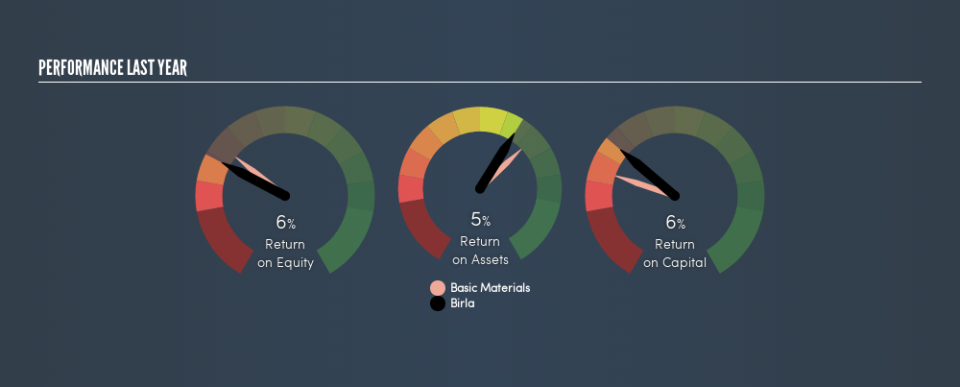How Do Birla Corporation Limited’s (NSE:BIRLACORPN) Returns On Capital Compare To Peers?

Want to participate in a research study? Help shape the future of investing tools and earn a $60 gift card!
Today we are going to look at Birla Corporation Limited (NSE:BIRLACORPN) to see whether it might be an attractive investment prospect. Specifically, we're going to calculate its Return On Capital Employed (ROCE), in the hopes of getting some insight into the business.
First, we'll go over how we calculate ROCE. Then we'll compare its ROCE to similar companies. Last but not least, we'll look at what impact its current liabilities have on its ROCE.
Understanding Return On Capital Employed (ROCE)
ROCE measures the 'return' (pre-tax profit) a company generates from capital employed in its business. All else being equal, a better business will have a higher ROCE. Ultimately, it is a useful but imperfect metric. Author Edwin Whiting says to be careful when comparing the ROCE of different businesses, since 'No two businesses are exactly alike.'
How Do You Calculate Return On Capital Employed?
Analysts use this formula to calculate return on capital employed:
Return on Capital Employed = Earnings Before Interest and Tax (EBIT) ÷ (Total Assets - Current Liabilities)
Or for Birla:
0.06 = ₹5.7b ÷ (₹111b - ₹16b) (Based on the trailing twelve months to December 2018.)
Therefore, Birla has an ROCE of 6.0%.
Check out our latest analysis for Birla
Does Birla Have A Good ROCE?
When making comparisons between similar businesses, investors may find ROCE useful. We can see Birla's ROCE is meaningfully below the Basic Materials industry average of 9.8%. This performance is not ideal, as it suggests the company may not be deploying its capital as effectively as some competitors. Regardless of how Birla stacks up against its industry, its ROCE in absolute terms is quite low (especially compared to a bank account). There are potentially more appealing investments elsewhere.
Our data shows that Birla currently has an ROCE of 6.0%, compared to its ROCE of 3.5% 3 years ago. This makes us think the business might be improving.
It is important to remember that ROCE shows past performance, and is not necessarily predictive. Companies in cyclical industries can be difficult to understand using ROCE, as returns typically look high during boom times, and low during busts. ROCE is, after all, simply a snap shot of a single year. What happens in the future is pretty important for investors, so we have prepared a free report on analyst forecasts for Birla.
Birla's Current Liabilities And Their Impact On Its ROCE
Current liabilities include invoices, such as supplier payments, short-term debt, or a tax bill, that need to be paid within 12 months. The ROCE equation subtracts current liabilities from capital employed, so a company with a lot of current liabilities appears to have less capital employed, and a higher ROCE than otherwise. To counteract this, we check if a company has high current liabilities, relative to its total assets.
Birla has total liabilities of ₹16b and total assets of ₹111b. As a result, its current liabilities are equal to approximately 14% of its total assets. This is a modest level of current liabilities, which will have a limited impact on the ROCE.
Our Take On Birla's ROCE
While that is good to see, Birla has a low ROCE and does not look attractive in this analysis. You might be able to find a better buy than Birla. If you want a selection of possible winners, check out this free list of interesting companies that trade on a P/E below 20 (but have proven they can grow earnings).
If you are like me, then you will not want to miss this free list of growing companies that insiders are buying.
We aim to bring you long-term focused research analysis driven by fundamental data. Note that our analysis may not factor in the latest price-sensitive company announcements or qualitative material.
If you spot an error that warrants correction, please contact the editor at editorial-team@simplywallst.com. This article by Simply Wall St is general in nature. It does not constitute a recommendation to buy or sell any stock, and does not take account of your objectives, or your financial situation. Simply Wall St has no position in the stocks mentioned. Thank you for reading.

